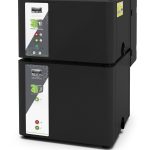By Lutz Graumann, business development manager for panel builders and partners, Eaton, and František Štepán, technical marketing manager for product systems and services, Eaton
Applying best practice to power distribution is not just a question of maximising energy efficiency. It is also a major safety concern.
The risk of arc flash and fire that can arise from low-voltage switchgear assemblies makes the implementation of suitable equipment and procedures an essential means by which to protect the lives of workers, reduce the risk of catastrophic damage and help ensure continuous operations.
The design of installations must be carefully considered for the avoidance of faults. Contact between live metal parts within the switchgear is a cause of short circuit currents, which can damage equipment. However, in many cases, such contact additionally creates an arc flash, which poses a serious risk to anyone working nearby as well as the switchgear itself and surrounding equipment.
In the case of an arc flash, a massive build-up of temperature and pressure within the switchgear has explosive consequences, sending molten metal and other switchgear components flying through the air. This not only endangers operational or maintenance staff working in the vicinity of the switchgear but typically destroys the switchgear assembly and can cause additional damage to nearby equipment and facilities. It is not unusual for doors and windows in the building to be destroyed by the release of energy.
What is more, the subsequent power outage and time required to organise replacement switchgear assembly can lead to prolonged periods of downtime – the effects of which are particularly acute in power-critical commercial buildings such as process plants, industrial facilities, data centres, hospitals and transport hubs.
In other words, the few seconds in which that raw and intense outburst of destructive energy occurs can have consequences that stretch into weeks and even months.
To minimise such risks, a number of measures can be put in place to protect people, property and operational continuity. Here are five steps to safety that should be considered by chief engineers, designers, consultants, technicians and installers.
1. Assess the risks
A comprehensive survey must be carried out in advance of any switchgear installation or upgrade. Since the majority of low-voltage switchgear is custom-built, there is no uniform safety specification and therefore the measures to be taken will depend entirely on the installation, its location and its likely usage. With this in mind, it is also important to review the assessment at regular intervals, since regulations, market and customer requirements typically change over time. It is not unusual for expansions of the workplace to create extra demand that increases pressure upon the energy supply and its consistency.
As part of the assessment, considerations to keep in mind include the switchgear model, whether it is a fixed installation or plug-in design, and what level of internal separation exists. Another consideration is the degree of maintenance required depending on the age of the assembly, which could mean an engineer working on it more frequently than usual. This is something that should be factored into the design from the beginning.
The role of technology is evolving rapidly in this area, with the launch of innovative tools that help to assess the risks that might exist in a particular design and indicate the safety features that are required to address those risks. It is advisable to seek safety advice from a reputable manufacturer at the earliest stage of the design process.
For existing installations, the age of the switchgear should be considered, as well as its environment. It is also important to take into account the location where the assembly will be placed – factors like humidity, dirt and seismic activity can affect the electrical functionality of the switchgear.
Another component of the assessment should be an examination of the ways in which the switchgear is accessible. A key question is whether non-professionals or sub-contracted staff have access to the switchgear assembly, thereby heightening the risk of an arc flash.
To help ensure the integrity of the switchgear and the safety of anyone working on or near the installation, the safety assessment should include a review of maintenance, monitoring and operating procedures – and whether these are predefined and standardised according to accredited instructions. The routine use of personal protective equipment (PPE), including clothing, should also be seen as an important part of the best practice programme. Additionally, training is crucial, since seemingly small errors such as dropped tools can be catastrophic when working directly within open switchgear assemblies.
To minimise the safety risk, it is worth remembering the five basic rules that apply when working on electrical equipment. Firstly, disconnect the equipment from the mains; secondly, take steps to prevent reconnection; thirdly, test to ensure the absence of harmful voltages; fourthly, make sure there is protection from earth leakage and short circuits; and finally, cover or close any live parts.
2. Be aware of regulations
The fundamental requirements of the installation are set out by the International Electrotechnical Commission’s IEC61439 standard for switchgear assembly. One of the requirements, for example, is for type certificates, which are typically acquired by a process of testing. Type certificates should cover key areas including material strength, protection class of housings, air gaps and creepage distances, protection against electrical shock and earth leakage, installation methods, internal circuits and connections, insulation properties, short-circuit resistance and electromagnetic compatibility.
A key characteristic to look for in any new switchgear is the internal separation of the switchgear. Generally speaking, the better the internal separation, the better the level of protection against potential problems such as arc faults. This is particularly pertinent for periods when engineers are working on an open switchgear assembly.
However, it is important to note that compliance with IEC 61439, while being a fundamental step, may not be sufficient to ensure the highest possible levels of protection. Newer technologies (which will be explored in more detail later) are enabling enhanced protection that goes beyond what is required by the standard and thereby further reduces the risk of damage or dangerous incidents occurring. In some countries, the evaluation of a risk hazard in a workplace needs to be carried out by the employer. This is also applicable for situations where engineers are working on, or close to, the switchgear assembly.
The latest development in safety strategy for electrical equipment is to evaluate the risk of burns arising from an electrical arc. The completion of an Arc Flash Hazard Analysis is already mandatory in Europe under the EN 50110 part 1 edition 3 standard. This is based on the requirements of the NFPA 70E-2015 standard, which has long been established in the USA. This is the only regulation that establishes a method for calculating incident energy. Knowledge of this standard is a prerequisite for objective assessment of arc flash risk when working on a bus.
3. Handle with care
One of the most common causes of arc flash is some form of contact with the live switchgear assembly, during installation, operation and maintenance.
A major influence on the ease with which the switchgear can be serviced is the way in which it is installed, either as a fixed installation or a plug-in design. In applications where the power supply availability is critical, the plug-in design is recommended since switchgear can be replaced much faster than for fixed equipment..
Switchgear in line with EN61439 includes the requirement for finger-safe (IP2X) covers to prevent the operator from making direct contact with live parts such as the terminations and main busbars for example. This includes automatic shutters which block access to the main busbar or distribution busbar once the plug-in unit has been removed.
Technology also has a growing role. Eaton, for example, has launched xSpider with an ArcRisk module. This is a unique software tool that can evaluate the risk of carrying out work on Eaton’s distribution switchboards. The ArcRISK module is based on calculations of short circuit current, which converts the value of incident energy and quantifies the impact of individual protective measures, enabling it to propose potential solutions.
4. Monitor performance
The operating temperature within the switchgear provides a strong indication of any problems that may be arising. Ageing, overloaded or poorly-maintained switchgear, or switchgear containing loose connections, can be vulnerable to the development of ‘hot spots’. These not only raise the risk of a fire outbreak but can also contribute to the conditions under which an arc flash occurs. Loose connections could create a serial arc fault, which can lead to a more serious arcing incident.
Thermography has been the traditional method by which temperature variations are detected. However, this approach is severely limited in its effectiveness and accuracy, since its visibility of some internal areas may be obscured by other parts. Additionally, it indicates only an ‘instantaneous value’ which limits its usefulness.
A great deal of research and development has been spent on the creation of a more accurate solution. Eaton’s DIAGNOSE system, for example, offers continuous temperature monitoring, 24 hours a day and seven days a week, benefits from a radial topology.
Radio temperature sensors, which are self-powered to enable contact with even the most hard-to-reach points on busbars within the switchgear, are linked to a controller. The system compares contemporary measurements with established threshold values based on thousands of tests, ensuring the switchgear’s maximum potential is reached, without any risk of overloading. Warnings and alerts can be issued immediately in the case of an urgent problem being detected. However, data can also be analysed locally or remotely, and the ability to download data in standard Excel graph formats is important for long-term archiving and evaluation of trends.
Monitoring of this kind enables predictive maintenance so that repairs can be carried out in a planned manner with minimal interruption of energy supply.
5. React fast
As well as reducing the likelihood of potentially-damaging errors through continuous temperature monitoring, it is also vital to implement devices that limit the level of damage that is inflicted when a major fault does occur. This is particularly vital for power-critical applications requiring an extremely reliable energy supply and with high short-circuit levels.
Eaton’s patented ARMS™ (Arc Reduction Maintenance System) solution reduces the trip time delay of power circuit-breakers after a short circuit. It is used in the Eaton IZM and IZMX Air Circuit Breakers series up to 6300A. The ARMS function is activated either manually by the operator or automatically using a limit switch when opening the door to the busbars. The significantly decreased value of incident energy minimises the operator’s risk of arc flash.
An active arc fault protection system, such as Eaton’s Arcon system, drastically reduces the energy generated by an arc flash by limiting its burning time to an absolute minimal number of milliseconds. It should be noted that while many commercially available systems react in a timescale of 20 to 50 milliseconds, Eaton’s Arcon system is unique in that its reaction time is only two milliseconds.
There’s a saying that every second counts. In the case of arc flash, every millisecond counts. By identifying an arc flash andApplying best practice to power distribution is not just a question of maximising energy efficiency. It is also a major safety concern.





